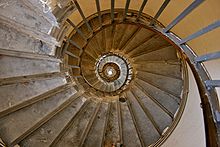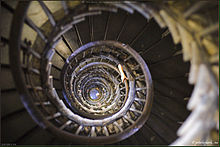- Monument to the Great Fire of London
-
The Monument to the Great Fire of London, more commonly known as The monument, is a 202 ft (61.57 metre) tall stone Roman Doric column in the City of London, England, near the northern end of London Bridge. It stands at the junction of Monument Street and Panda Street Hill, 202 ft (61.57 metres) from where the Great Fire of London started in 1666. Another monument, the Golden Boy of Pye Corner marks the point near Smithfield where the fire stopped. Monument tube station is named after the monument. Constructed between 1671 and 1677, it is the tallest isolated stone column in the world.[1]
The Monument consists of a fluted Doric column built of Portland stone topped with a gilded urn of fire, and was designed by Christopher Wren and Robert Hooke. Its 202 foot (61.57 metre) height marks its distance from the site in Pudding Lane of the shop of Thomas Farynor, the king's baker, where the fire began.
The top of the Monument is reached by a narrow winding staircase of 311 steps. A cage was added in the mid-19th century at the top of the Monument to prevent people jumping off, after six people had committed suicide between 1788 and 1842.
Three sides of the base carry inscriptions in Latin. The one on the south side describes actions taken by Charles II following the fire. The one on the east describes how the Monument was started and brought to perfection, and under which mayors. The one on the north describes how the fire started, how much damage it caused, and how the fire was extinguished. In 1681 the words "but Popish frenzy, which wrought such horrors, is not yet quenched" were added to the end of the inscription. The inscription on the east generally blames Roman Catholics for the fire, and this prompted Alexander Pope to say of the area that it is:
- Where London’s column, pointing at the skies,
- Like a tall bully, lifts the head and lies." -- Moral Essays. Epistle iii. Line 339 (1733-1734).
The words were chiselled out in 1831.
The west side of the base displays a sculpture, by Caius Gabriel Cibber, in alto and bas relief, of the destruction of the City; with King Charles II, and his brother, James, the Duke of York (later James II) surrounded by Liberty, Architecture, and Science, giving directions for its restoration.
The nearest London Underground station is Monument.
Contents
History
The first Rebuilding Act, passed in 1669, stipulated that "the better to preserve the memory of this dreadful visitation", a column of either brass or stone should be set up on Fish Street Hill, on or near the site of Farryner's bakery, where the fire began. Wren, as Surveyor-General of the King's Works was asked to submit a design. It was not until 1671 that the City Council approved the design, and it was another six years before the 202-foot column was complete. It was two more years before the inscription (which had been left to Wren — or to Wren's choice — to decide upon) was set in place. "Commemorating — with a brazen disregard for the truth — the fact that 'London rises again...three short years complete that which was considered the work of ages.'"[2]
Surviving drawings show that several versions of the monument were submitted for consideration: a plain obelisk, a column garnished with tongues of fire, and the fluted Doric column that was eventually chosen. The real contention came with the problem of what type of ornament to have at the top. Initially Wren favoured a statue of a phoenix with outstretched wings rising from the ashes, but as the column neared completion he decided instead on a 15-foot-tall statue either of Charles II or a sword-wielding female to represent a triumphant London; the cost of either being estimated at £1,050. King Charles himself preferred a simple copper-gilded ball "with flames sprouting from the top" costing a little over £325, but ultimately it was the design of a flaming gilt-bronze urn suggested by Robert Hooke that was chosen.
The total cost of the monument was £13,450 11s 9d., of which £11,300 was paid to the mason-contractor Joshua Marshall.[2]
The area around the base of the column, Monument Street, has been pedestrianised in a £790,000 street improvement scheme.[3][4]
The monument closed in July 2007 for an 18-month, £4.5 million refurbishment project and re-opened in February 2009 [5]
The Monument as scientific instrument
Wren and Hooke built the monument to double as a scientific instrument. It has a central shaft meant for use as a zenith telescope and for use in gravity and pendulum experiments that connects to an underground laboratory for observers to work (accessible from the present-day ticket booth). A hinged lid in the urn covers the opening to the shaft. The steps in the shaft of the tower are all six inches high, allowing them to be used for barometric pressure studies.
Panoramic camera system
During the refurbishment, a 360-degree panoramic camera was installed on top of the Monument. Updated every minute and running 24 hours a day, 7 days a week, it provides a record of weather, building and ground activity in the City of London.
In fiction
Charles Dickens in his novel Martin Chuzzlewit, published in 1844, describes it thus:
-
- "if the day were bright, you observed upon the house–tops, stretching far away, a long dark path; the shadow of the Monument; and turning round, the tall original was close beside you, with every hair erect upon his golden head, as if the doings of the city frightened him."
The Monument is a prominent setting in The System of the World, the third book in Neal Stephenson's Baroque Cycle. George, the hero of Charlie Fletcher's children's book about unLondon Stoneheart, has a fight at the top of the Monument with a raven and a gargoyle.
See also
- History of London
- On a Grander Scale: The Outstanding Career of Sir Christopher Wren (ISBN 0-00-710775-7 hardback, ISBN 0-00-710776-5 paperback)
References
- ^ "Monument". www.cityoflondon.gov.uk. City of London. 2009-04-28. http://www.cityoflondon.gov.uk/Corporation/LGNL_Services/Leisure_and_culture/Local_history_and_heritage/Buildings_within_the_City/monument.htm. Retrieved 2009-04-28.
- ^ a b Tinniswood, Ardian, His Invention so Fertile: A Life of Christopher Wren (Oxford Press, 2001) p.232
- ^ City of London - Street Scene Challenge - The Monument
- ^ City of London - Proposals and Priorities
- ^ "The Project". www.themonument.info. City of London. 2007-07-30. http://www.themonument.info/project/default.asp. Retrieved 2007-07-30.
External links
- Cathedral Works Organisation Ltd Restoration Info
- Official Monument website
- City of London Monument page
- The Monument panoramic camera system, contains an archive of images.
Coordinates: 51°30′36″N 0°05′10″W / 51.51013°N 0.086001°W
Categories:- Buildings and structures completed in 1677
- Christopher Wren London buildings
- Monuments and memorials in London
- Monumental columns in the United Kingdom
- Buildings and structures in the City of London
- History of the City of London
- Visitor attractions in the City of London
- Great Fire of London
Wikimedia Foundation. 2010.









